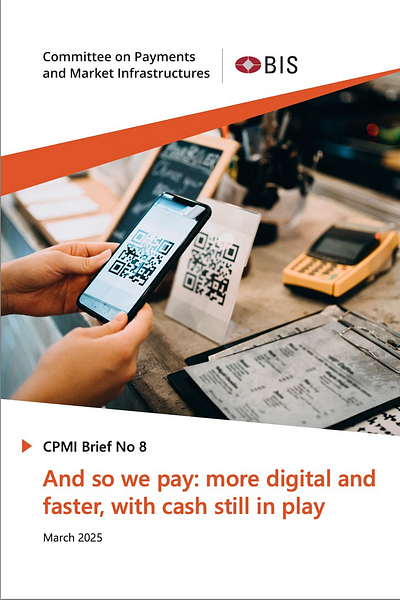The Cashless Revolution Is Here—And Emerging Markets Lead
Cashless payments are continuing to rise globally.
This is my daily post. I write daily but send my newsletter to your email only on Sundays. Go HERE to see my past newsletters.
HAND-CURATED FOR YOU
The BIS shows how the world is going “Cashless,” with the use of credit transfers and e-money growing worldwide as emerging economies take the lead.
This report from the BIS has fabulous graphs, and I encourage you to open up this PDF and take a look.
The reality is that people want the convenience of cashless payments, and once they try them, particularly for small items, they don’t want to go back to cash.
I don’t blame them. Do you?
The oddest moment for me on a recent trip back home to Italy was when I found an uncomfortable lump of coins in my pocket, as I have grown accustomed to a cashless life here in China.
Unsurprisingly, fast payments are the rocket fuel for this transition and a sign of increasing credit transfers and digitalization of payments.
Cards rule in advanced economies and are used roughly half as much in emerging markets, showing once again that cards are fighting for relevance in the developing world.
And Cash? Cash isn’t going anywhere. Cash in circulation in emerging and developed economies continues to drop, but ever so slowly, showing that it will be around for quite a while.
The BIS shows that there’s no going back!
👉Highlights
🔹 EMDEs LEAD: On average, the per capita annual number of both credit transfers and e-money payments was higher in EMDEs (104 and 68, respectively) than in advanced economies (98 and 22, respectively).
🔹 On average, the number of annual cashless payments per capita in EMDEs grew 29%, from 293 to 377, compared with 4% (from 468 to 487) in advanced economies (AEs).
🔹 The use of credit transfers (+35%) and e-money (+48%) grew strongly in EMDEs driven by the growing use of fast payments.
🔹 Cards rule in AEs: On average, in AEs, cards were used 306 times per person in 2023, as opposed to 188 times in EMDEs
🔹 Fast payments are a prominent sign of the increasing digitalisation of payments.
🔹 Over the past 10 years, the number of payment accounts offered by nonbanks has grown. Between 2020 and 2023, the number of non-bank payment accounts per capita grew by more than 65% in Mexico and by more than 200% in Argentina.
🔹 In 2023, cash in circulation as a percentage of GDP continued to decrease in most CPMI jurisdictions.
🔹 Cash in circulation was highest in Japan (22%) and Hong Kong SAR (20%) and lowest in Sweden (0.9%) and Türkiye (2%).






